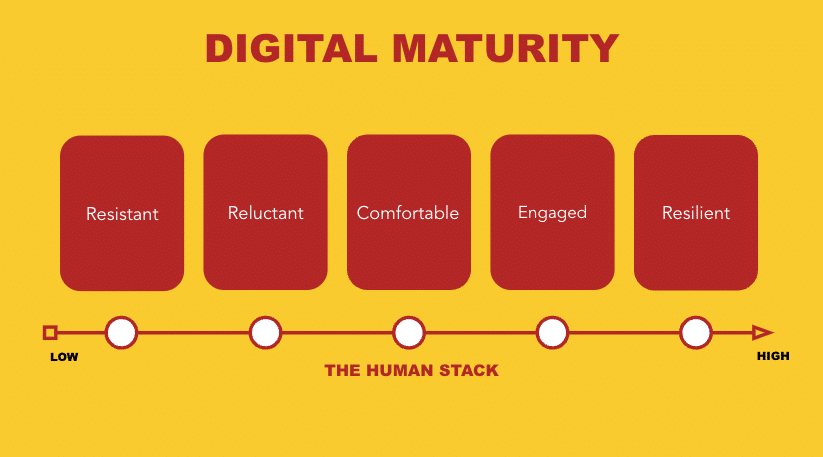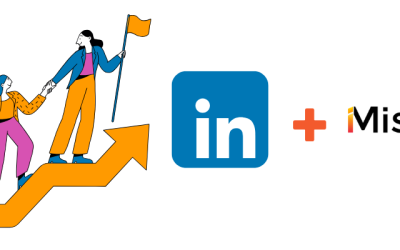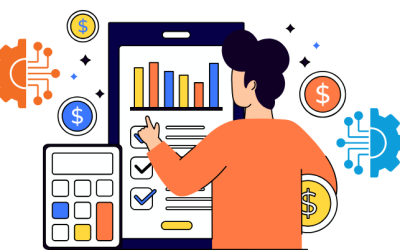Has the rapid evolution of information technology become more of a boon or a burden for your nonprofit? If burden is your answer, you’re not alone. That’s because in our fast-paced virtual world, organizations must not only harness the power of technology but also cultivate a healthy digital culture in order to thrive.
But what exactly does it mean to have a healthy digital culture, and why is it so crucial for the success of nonprofit organizations? Let’s talk about the tricky intersection of technology and culture, and gain actionable steps to navigate it successfully.
Importance of Digital Culture in Nonprofits
Fostering a robust digital culture isn’t just a luxury—it’s a necessity. At The Human Stack, we recognize the pivotal role digital culture plays in amplifying impact and driving organizational success. By creating a healthy digital culture, nonprofits can increase their reach and impact, by inspiring buy-in concerning the proper use of digital platforms.
A healthy digital culture streamlines operations, boosting efficiency and enables teams to focus on what truly matters: advancing their mission. Through innovative tools and strategies, nonprofits can revolutionize donor engagement and fundraising efforts, creating meaningful connections and inspiring action like never before.
If your nonprofit organization is equipped with cutting-edge technology but lacks a cohesive digital culture, the tech will not give you your desired outcomes. Over the past 20 years I’ve seen repeatedly that despite the state-of-the-art tools at their disposal, organizations struggle to harness their full potential.
Why?
Because technology is only as effective as the people who use it. It’s not just about the software; it’s about the mindset and behaviors that shape how technology is embraced and utilized within the organization.
Challenges in Building a Nonprofit Digital Culture
Building a healthy digital culture is easier said than done. Nonprofits face so many challenges on this journey, from resource constraints to resistance to change. Limited time, budget, and personnel often hold up efforts to invest in digital literacy and training, leaving staff feeling overwhelmed and ill-equipped to navigate the digital landscape. Plus, keeping pace with all of these evolving technologies poses a significant challenge, as nonprofits struggle to stay ahead of the curve while juggling their day-to-day operations. Additionally, the digital divide and accessibility issues add to the mess, as marginalized communities are often left behind in the digital revolution.
What Is A Healthy Digital Culture?
A healthy digital culture is characterized by an openness to engage with various digital tools, digital technologies, social media, and digital platforms, recognizing their significant value to daily tasks and responsibilities.
With the internet becoming a hub for learning opportunities, online courses enable nonprofits to train their employees more efficiently. Digital technology and its consistent innovation have paved the way for more accessible and diversified communication methods. This has created a distributed workforce, changing how people communicate, maintain relationships, and foster a sense of belonging.
What Is Digital Maturity?
Since a digital culture’s health is also determined by digital maturity, it’s important to know about digital maturity and how it works. At The Human Stack, we’ve identified 5 groups people might fall into when it comes to their digital maturity.
- Resistant – actively lean away from technology
- Reluctant – passively lean away from the technology
- Comfortable – Technology is “just there”
- Engaged – lean into the technology but not obsessed
- Resilient – lean into the technology for its own sake and might be a little bit obsessed with the technology

Moving Digital Maturity Forward
In order to move a digital culture forward toward the comfortable – resilient end of the spectrum, there are a couple of key strategies.
Engaged users are your secret key to driving a digital culture – they have the tips and tricks to using the tech and the excitement to share with others but aren’t so obsessed they run the risk of isolating non-engaged users (as resilient users may do). Additionally, engaged users focus on how the tech makes their job easier and better – meaning that they will have exactly what users are looking for – actionable steps to making a job easier and better.
Fostering a Healthy Digital Culture
Now that you understand the connection between digital maturity and digital culture, you might be wondering how to actually apply this unique insight. We will dig into the following four tips to help you foster a healthy digital culture:
- Create employee engagement
- Decrease change saturation to increase nonprofit digital culture
- Foster digital culture within each department
- Take the Digital Health Quiz
1. Create Employee Engagement
So here’s the first actionable tip: Host a lunch in which engaged users share their uses of technology. (Hint: make sure there’s food. Food fuels the human stack and fuels attendance!) This lunch will allow reluctant and resistant people to see an example of the ways in which technology is positively influencing their coworkers’ workday and, hopefully, begin getting ideas for how the technology can improve their own workday.
Let’s call our engaged user Kathy and our reluctant user Sarah. They are both employees at the same nonprofit. Sarah doesn’t necessarily think the new CRM is bad, but she’s worried she doesn’t know how to use it properly and feels overwhelmed by the new change. At this lunch, Sarah is able to hear how Kathy uses the system. Kathy shared at this lunch how she’s used the CRM to know the best way to reach out to a client – something Sarah was frustrated didn’t exist in the previous system. This makes Sarah finally feel excited about a feature of the new CRM and begins moving her toward the comfortable end of the spectrum.
Additionally, Sarah now knows Kathy might be a resource to go to within their organization if she has questions about how to use the CRM properly. So, in one lunch, Sarah has both begun to feel excited about the new system and has learned about an internal resource she can go to if she feels overwhelmed.
2. Decrease Change Saturation to Increase Nonprofit Digital Culture
Another factor that affects digital maturity, and by extension, digital culture, is change saturation. Change saturation is the point at which there has been so much disruption that people can’t handle it anymore. Exceeding the change saturation point can create digital immaturity. One good way to ensure a healthy digital culture is to have a good idea of what level of change people are able to handle in order not to exceed change saturation. Check out our blog post, User Expectations, for more on change saturation, change management, and how to foster a sense of belonging in an organization.
It’s important always to ensure that the changes you’re implementing are below the change saturation level, or you can create digital immaturity. When people are overwhelmed and have had their work disrupted, it’s tough to engage with technology in a healthy way. This leads to an unhealthy digital culture where people are burnt out, frustrated, and unwilling to engage with technology actively.
Digital Guidance, our methodology, moves maturity (slowly and methodically) forward. Change Saturation does exactly the opposite, it moves digital maturity backwards quickly and chaotically.
Digital Guidance®, our methodology, moves maturity (slowly and methodically) forward. Change Saturation does exactly the opposite; it moves digital maturity backward quickly and chaotically.
3. Foster Digital Culture within each individual department
Digital culture is not a singular entity confined to the top echelons of an organization; it’s an amalgamation of the microcultures that thrive within individual departments. Particularly in nonprofits, where each team has distinct functions and dynamics, the digital culture is shaped by the collective harmony of these individual team cultures.
The mistake many organizations make is centralizing digital responsibilities, often relegating them to the IT department or a sole leadership position. In reality, every department, from marketing to HR to fundraising, is integral to the digital transformation journey. Each has its unique tools, platforms, and needs, but all should equally share the ownership of evolving their digital maturity. By doing so, they not only enhance their efficiency but also align with the broader digital objectives of the organization.
Our approach, Digital Guidance®, works by nurturing one department at a time. We guide each team along the digital maturity spectrum, aiming to achieve resilience. Once a team is synchronized in its digital approach, its culture becomes a beacon for the organization’s overarching digital vision. Moreover, individuals within these teams, having honed their digital skills, emerge as champions, fostering digital maturity across other departments and creating a cohesive, organization-wide digital culture.
4. Take the Digital Health Quiz
Before spending money on new tools, new technologies, or consulting, start by gauging where your system (and your culture!) currently is. The Digital Health Quiz analyzes your current system in two ways: the tech stack and the human stack.
Focusing on improving the items and issues identified for the human stack in your Digital Health Quiz can be a great way to support and jumpstart digital transformation and foster a healthy digital culture at the same time!
Putting it all Together
In conclusion, a healthy digital culture is built on the willingness of individuals to adapt, embrace technology, and utilize it effectively. Embracing a healthy digital culture is not only an essential aspect of staying relevant in today’s digital age but also a catalyst for positive change and success in the nonprofit sector.
About the Author
Tim Lockie, Founder & CEO of The Human Stack
Tim Lockie brings a wealth of experience and credibility to the field of leadership and technology. With 30 years of leadership experience, 20 years in the tech industry, and a decade dedicated to advising and consulting, Tim has a proven track record of success. In 2022, he transitioned from managing a seven-figure consulting firm in the Salesforce Ecosystem to founding The Human Stack, a venture dedicated to building organizational capacity for social impact through human empowerment. Tim’s commitment to making a difference ensures he focuses on empowering people, not just technology.



